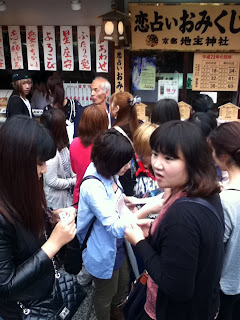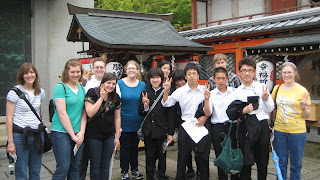Kyoto was established as the capital of Japan during the Heian Period (8th century AD). That means that there is 13 centuries of history in this city. I could definitely feel the antiquity in the city, a sensation that I was looking directly into the past. I am told that only Nara rivals Kyoto in this regard. I eagerly await the day we go there too.
Our Saturday started early; we (Taylor, Sarah, and I, the Osakans) needed to meet up with the interns in Kobe in time to go together to our first destination in Kyoto. A gentle rain fell on and off as we went, though it never got very heavy. The ride took about 2 hours total, and was quite pleasant despite the precipitation.
was a dais that ran the entire length of the temple (which is the name of the temple itself; sanjusangen literally means "thirty three ken (a length of roughly 1.8 meters)," which equates roughly to 195 feet). On the dais stood 1,001 statues of the Buddhist deity, Kannon, the Goddess of Mercy. I was floored. Aside from the central figure (which was around 11 feet tall), all 1,000 of them were human sized, carved from cypress and covered in gold (or gold coloring). There were also 28 other statues representing various other deities from the Buddhist tradition, including Raijin (god of lightning) and Fujin (god of wind). Picture taking of these venerated objects was not allowed, but here are a few pictures from the web.
The statues of the Thousand Armed Kannon, as well as protective deities in front.
An image of Raijin, the God of Lightning
The image of Fuujin, the God of Wind
We were even afforded the rare opportunity to see the preparations for a Buddhist wedding that was to be held in front of the main statue of Kannon. Buddhist wedding ceremonies are rare in Japan, as Shinto tradition usually is followed for weddings. The ceremony must have been exquisite.
The dedication and resolve it must have taken to originally carve all these statues.... That was what was most impressive to me (aside from the fact that the craftsmanship itself was nonpareil). There were other amazing things too, like some memorials that were created for a few people over the history of the temple. They had accomplished near super-human feats in an annual archery competition held there called Toshiya. One eleven year old boy named (I think) Kota Kingo who, in the course of 24 hours, shot 11,910 arrows and hit his target (half the length of the temple) 11,760 times; that's 98.7 percent accuracy. Yowzers!
Here are a couple other pictures of the view in Sanjusangen-do. Pardon the crazy guy in the foreground; he just wouldn't get out of the way.
This was essentially my expression all day.
I'm in freaking Japan, suckahs!
Find the duck in this photo.
After leaving this awesome temple, we drove across Kyoto to another awesome temple, Kiyomizu-dera. I had heard the name of this one, but I didn't know what to expect, save something amazing. Needless to say, it exceeded my expectations in every respect.
At the beginning we passed a gate that had two large statues in the pillars. One was had his mouth open and was called "Ah," and one had his mouth closed and was called "Un." Since the sounds 'a' and 'n' are the first and last sounds in the Japanese syllabary, these statues essentially represented Alpha and Omega and were the judges of those who passed before them.
They're behind the green covers, so getting a picture didn't really work, but....
We proceeded through the grounds, taking in the gorgeous pagodas and pavilions. Here's me trying to look menacing beneath the gaze of the komainu.
Maybe less menacing and more "please don't eat me!"
We eventually made it to the main pavilion, where we were afforded a breathtaking view of Kyoto city and the mountain greenery.
This temple was constructed entirely without nails; they interlocked the timbers by carefully fitting them together piece by piece. This edifice was truly mesmerizing.
There is an expression in Japanese, "like jumping off the Kiyomizu-dera stage," which is often used in phrases of encouragement, like "Be courageous enough to jump off the Kiyomizu stage," or "Keep at it with tenacity enough to jump from Kiyomizu." I learned that tidbit from Sister Sugimoto. It's great to have natives with you to explain cultural points that you would otherwise miss.
Aaand it's this guy again. He looks completely lost.
This temple fits the mountainside Buddhist temple image perfectly. Though the sheer number of patrons and tourists detracted a little bit from the image, I still felt like I was experiencing in some degree the way of life of the Japanese. The main pavilion had a place to try different Buddhist rituals, like tossing coins into a coffer for good luck (like a wishing well, I suppose) and ringing a big cauldron-shaped bell. The resonating gonnnnnnggggg was oozing with the zen vibe I'd been feeling all day. It was exhilarating.
We took a small detour in the temple to visit Jishu-jinja, a Shinto shrine that was located on the grounds. It specialized in enmusubi, or amulets/charms for love and marriage.
"Jishu-jinja; the enmusubi god." And a couple junior high school girls (naturally) to complete the image.
As I expected, the shrine was overflowing with girls who were buying charms or getting love fortunes.
A dozen clamoring women and one old geezer. Demographics seem to fit perfectly!
There is a pair of rocks in the shrine where it is said that if you can walk between the two of them with your eyes closed, you will find true love. Other places for offerings and prayers abounded.
Incidentally, we met a gaggle of junior high students next to them, and one of them was brave enough to ask us a few questions in English (presumably for homework). They wanted a picture, so we obliged.
Eventually we got to the end of the temple, where the spring for which the temple is named (Kiyomizu means "pure/clean water") was located. I had a drink from the stream to have a long life and good health, so we'll see how well its effects last.
I worked hard for that water.
With two temples under our belts, we felt it was time for food. We wanted something fast so we could get right back at it, so we went to McDonalds for lunch. The food was just as it is in America, save in smaller portions. Anticipating the size difference, I made sure and ordered everything large, which also happened to net me a special prize.
Thank you, valued customer! Here is your souvenir can-shaped drinking glass!
After lunch we went off to see
Kinkaku-ji, a site I was very much looking forward to. The edifice itself is marvelous. It is just so beautiful to look at. On calm days the lake acts as a natural mirror to make the scene even more surreal and beautiful.
That ain't fools gold on that there building. That stuff's legit.
The lake also was home to some MONSTER koi fish. I mean, I know they're carp, but these things were gigantic!
Not a very good shot, but there they are.
Also, there's a phoenix on top of the pavilion, although from the ground it kind of looks like a rooster.
The grounds were magnificent. It is said that the grounds mimic the idea of the Western Paradise in Buddhist thought, and I can see why one might consider it paradisaical. The greenness and serenity in nature here is palpable in places like this.
Although, if we're gonna talk about nature, serenity, and feelings of inner peace, then no place is better than
Ryoan-ji, our last stop on this trip. I mean, each place on this trip had its own moments of breathtaking awe and wonder, where I could not help but marvel at what I was seeing and experiencing. But in terms of something profound and essentially spiritual, I found Ryoan-ji to be the most...well, enlightening.
Nothing like a lotus pond to put you in a meditative state of mind.
Ryoan-ji is famous for its Rock Garden. It was purposefully crafted so that, as you gaze upon the simple structure and count the stones that are strewn throughout, you can only see 14 stones, though in actuality there exist 15. It doesn't matter where you sit as you contemplate the scene; you can never see the whole picture. The meaning of this, of course, is up to each person who sees it, but I sense a message of imperfection, of mortal man's short-sighted perspective. If I stand up from my seat, however, all the stones are visible. It just takes a vantage point from somewhere higher up.

I sensed while looking at this the innate desire of man to organize, to create. I sensed echoes of our shared spiritual lineage again as I pictured the Japanese ancients as they crafted this scene. I imagined a day not unlike that day, where a soft rain fell against the roof and stones, the soft pitter-patter of it calming and soothing the mind. I imagined the wet stone and wood releasing a smell of earth and nature, inspiring the minds of the gardeners. And I imagined that, unconscious to them (and to us still), their souls stirred and cried out to the Creator as they too attempted to follow in His footsteps.











































